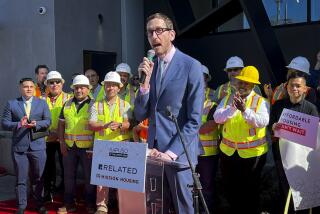California lawmakers have tried for 50 years to fix the state’s housing crisis. Here’s why they’ve failed
After an hour of debate, Herb Perez had had enough.
Perez, a councilman in the Bay Area suburb of Foster City, was tired of planning for the construction of new homes to comply with a 50-year-old state law designed to help all Californians live affordably.
Everyone knows, Perez told the crowd at a 2015 City Council meeting, that the law is a failure. It requires cities and counties to develop plans every eight years for new home building in their communities. After more than a year of work and spending nearly $50,000, Foster City had an 87-page housing plan that proposed hundreds of new homes, mapped where they would go and detailed the many ways the city could help make the construction happen. But a crucial element was missing: Foster City was never going to approve all the building called for in the voluminous proposal, Perez said.
“What I’m seeing here is an elaborate shell game,” Perez said. “Because we’re kind of lying. It’s the only word I can come up with. We have no intention of actually building the units.”
Perez’s prediction came true. Despite soaring demand for housing in the Bay Area, the city hasn’t approved any new development projects in more than five years.
Foster City’s experience is shared by governments across California: The law requires cities and counties to produce prodigious reports to plan for housing — but it doesn’t hold them accountable for any resulting home building.
The law, passed in 1967, is the state’s primary tool to encourage housing development and address a statewide shortage of homes that drives California’s affordability problems.
Now, a bill from Sen. Scott Wiener (D-San Francisco) would, for the first time, force cities and counties that have fallen behind on their housing goals to take steps to eliminate some of the hurdles they put in front of development, such as multiple planning reviews for individual projects. Wiener’s legislation passed the state Senate this month and is awaiting a vote in the Assembly as part of a package of bills aimed at addressing the state’s housing problems.
“The system is so broken,” Wiener said. “It gives the public a false sense that a step has been taken toward having more housing when in fact it’s just an illusion.”
One of the main criticisms of the law is that it hasn’t spurred enough new home building. Fewer than half of the 1.5 million new homes the law said developers would need to build over eight years leading up to 2014 — the law’s most recent reporting period — were built.
In addition, state officials don’t know if cities and counties have met their housing goals. Local governments are supposed to give the state information on home building each year, but many don’t. As a result, there is no reliable measure of how many houses are being built in California for low-, middle- and upper-income residents.
State lawmakers have known about the law’s weaknesses for decades but haven’t fixed them. They have added dozens of new planning requirements to the process but have not provided any incentive, such as a greater share of tax dollars, for local governments to meet their housing goals.
“The law has been completely ineffective at addressing the issue of housing affordability,” said Paavo Monkkonen, an associate professor of urban planning at UCLA. “If anything, it’s a waste of people’s time.”
Prison beds and student dormitories count as low-income housing?
California’s housing affordability troubles have contributed to the state’s poverty rate, which is the highest in the nation. It also has burdened millions with high rents and, according to a recent study by the McKinsey Global Institute, created a more than $100-billion annual drag on the state economy by lowering disposable incomes and limiting construction jobs.
Ben Metcalf, the state’s top housing official, has said the affordability problems are as bad as they’ve ever been in California’s history. And the state is expected to add an additional 6.5 million people over the next two decades.
The primary driver of the affordability problem is a lack of home building. Developers in California need to roughly double the 100,000 homes they build each year to stabilize housing costs, according to the McKinsey study and reports from the state Department of Housing and Community Development and nonpartisan Legislative Analyst’s Office.
Home construction depends on complex factors including the cost of land, materials and labor, the availability of financing for developers and interest rates on mortgages for homeowners. But decisions made by California’s cities and counties are important, too, and many of those local governments have made it even more difficult to build new housing.
More than two-thirds of California’s coastal communities have adopted measures — such as caps on population or housing growth, or building height limits — aimed at limiting residential development, according to the Legislative Analyst’s Office. A UC Berkeley study of California’s local land-use regulations found that every growth-control policy a city puts in place raises housing costs by as much as 5% there.
The housing supply law, known formally as the “housing element,” is supposed to help knock down local barriers to development by requiring cities to plan for new housing that would accommodate children born in California and people expected to relocate to the state. Over an eight-year period, state officials send estimates of housing needed to meet projected population growth to 19 regional agencies, including the Southern California Assn. of Governments in the Los Angeles area.
These agencies outline how many new homes are needed across four income levels: very low, low, moderate and above-moderate. So, in theory, all cities and counties would receive their fair share of growth. Local governments must show they’ve zoned enough land for the new housing — and the state must sign off on those plans. But the state doesn’t hold cities accountable for the goals they set, and the plans are often ignored.
Even so, city and county officials resent the law, arguing it unfairly takes away their power over development in their communities. To avoid complying, local governments have over the years asked state lawmakers to, among other things, count prison beds and student dormitories as low-income housing and allow cities that place foster children in their communities to reduce the number of low-income homes they need to plan for.
In one case, La Habra Heights, in Los Angeles County, asked that it be exempted from the law because the city was too hilly for apartment complexes.
‘People want to be with people who are like them’
At the base of the San Gabriel Mountains, the affluent bedroom community of La Cañada Flintridge has few apartment or condominium complexes — and many of the city’s 20,000 residents and public officials want to keep it that way.
Four years ago, city leaders wrote a plan to make room for multifamily housing in several sections of the city. But, to discourage developers, they chose areas already occupied by single-family homes and, in one case, a big-box retailer. As a result, developers would have needed to buy up the homes one by one or, in the case of the retailer, purchase the commercial real estate and force the store out. In devising the plan, city officials assured concerned residents that it would be prohibitively expensive for developers.
“Everybody on this dais and that’s here is on the same page,” Planning Commission Chairman Rick Gunter told the audience at a November 2013 hearing on the housing plan. “We like living here. We like the way it is now.”
Herand Der Sarkissian, a former La Cañada Flintridge planning commissioner who approved the city’s housing plan, said in an interview it didn’t make sense for the state to try to force low-income housing into La Cañada Flintridge because the city’s high land costs made it fiscally irresponsible. He added that any state efforts to integrate housing of all income levels into wealthy communities are doomed.
“People like people of their own tribe,” Der Sarkissian said. “I think the attempt to change it is ludicrous. Be it black, be it white. People want to be with people who are like them. To force people through legislation to change in that way is impractical.”
None of the multifamily housing called for in the La Cañada Flintridge housing plan has been built.
In Redondo Beach, officials told the state in 2014 they would work toward the city’s housing goal by supporting a proposed commercial and residential development with 180 apartments — nine of them reserved for very poor families — to replace a run-down strip mall and parking lot along the Pacific Coast Highway. The city zoned the land for that amount of housing.
But in numerous hearings over the next two years, planning commissioners and council members argued the development was too big, and the city ultimately approved 115 apartments with none set aside for low-income residents. The developer has since sued Redondo Beach and the project remains in limbo.
La Cañada Flintridge and Redondo Beach did not report housing construction data to the state from 2006 to ‘14. Some new homes were built in both cities, according to permit information, but far fewer than were outlined in the cities’ plans over that period.
These and similar examples across California show that the housing law is a “complete farce,” Wiener said. His legislation would do away with some planning reviews that are often levied on projects in cities that haven’t kept pace with their housing goals.
“Many local communities basically run a scam where they spend all sorts of time — lots of public hearings, lots of public discussion — and then it’s over and you have this collection of paper sitting on a shelf,” Wiener said. “It doesn’t result in any additional housing.”
‘With this living situation, I can’t even think of having children right now’
Sandwiched between wealthier communities to the north and south and more industrial areas to the east, the coastal Los Angeles County city of Torrance has swaths of single-family neighborhoods and lots of land for commercial and industrial business.
“At some point, a city should be allowed to say we’re full,” Bill Sutherland, then a Torrance city councilman, grumbled before voting for the city’s most recent housing plan in 2013. “I think we are actually at that point.”
Torrance’s growth has slowed. Less than half of 1,828 houses called for in the city’s previous housing plan were built, according to construction permit data.
The lack of home building has had consequences.
Nearly 40% of Torrance’s 147,000 residents now pay more than 30% of their incomes on housing, according to federal data. In 2014, Toyota Motor Corp. decided to relocate its North American headquarters — and 3,000 jobs — from Torrance to Plano, Texas, citing as one factor the Lone Star State’s lower cost of living.
High costs have left housing in Torrance out of reach for Azucena Gutierrez and other workers in the city.
Every weekday, Gutierrez goes into Torrance homes to teach prenatal and infant care to new and expectant parents. Gutierrez, 38, earns less than $15 an hour.
She lives in Los Angeles’ Boyle Heights neighborhood, crowding into a two-bedroom apartment with her husband, who is a substitute teacher, their 14-year-old son and 5-year-old daughter. Steep housing costs have forced Gutierrez’s older sister to move in with them too.
Gutierrez would like to live near her job and for her children to attend Torrance’s better rated schools. But the $1,600-a-month rent she saw advertised for a one-bedroom apartment in Torrance was more than the $1,500 she pays now for more room across town.
“I waste a lot of time in traffic,” Gutierrez said. “Time, I can’t get it back. I’m spending close to two hours driving every day. That’s 10 hours [a week] I could be spending with my family.”
Gutierrez’s colleagues share her struggles. Georgina Romero, 28, makes $13.50 an hour teaching toddlers and pays $600 a month to live with her boyfriend, mother, two younger siblings and her sister’s boyfriend in a three-bedroom house in Watts.
She moved there in March to help her mother with her housing costs. Before that, Romero paid $300 a month to live with her boyfriend in a 400-square-foot garage behind his parents’ house in Lawndale.
“I would love to have children,” Romero said. “But with this living situation, I can’t even think of having children right now. I don’t feel like I’m stable enough.”
Torrance Mayor Patrick Furey said he’s sympathetic to those who can’t afford to live in his city. But, he added, Torrance shouldn’t have to make changes to the character of its neighborhoods to accommodate new housing.
Instead of Torrance, he said, nearby cities should take on the needed growth.
“You won’t have the ZIP Code you want,” Furey said, “but it’s close enough.”
‘No intention of facing up to housing responsibilities’
The state’s housing law faced problems from the start.
In 1967, Gov. Ronald Reagan signed the law, which had a simple goal: Cities and counties would have to plan “for the housing needs of all economic segments of the community.” But just five months after the first plans were due in July 1969, state officials realized local governments were ignoring the law, with a report warning about “discouraging indications” that a number of communities had “no intention of facing up to housing responsibilities.”
Over the years, legislators passed numerous bills adding detailed rules to local government housing plans. But things only got worse.
By 1993, the law’s increased paperwork requirements turned it into “an energy- and money-guzzling bureaucratic maze,” said Timothy Coyle, then-director of the Department of Housing and Community Development, at a legislative oversight hearing that year. He called the law “broken” because it did nothing to encourage cities to permit more homes.
Coyle said in a recent interview that the law “was destined to fail.”
Today, the state lacks basic information on the law’s effectiveness. More than a quarter of California’s 539 cities and counties failed to tell the state how many homes were built within their boundaries over the eight-year period leading up to 2014, according to a Times review of housing department data.
Wiener’s legislation would require all cities and counties to turn in home-building data and remove some of their ability to review and block new development if they fall behind their housing goals.
Gov. Jerry Brown has also said he’d also support tying state financial aid to whether local governments met their housing goals. Still, if the state plans to hold cities and counties accountable for meeting those targets, the targets themselves might require reevaluation.
Bay Area counties are on track to meet their overall home-building goals for the eight-year reporting period ending in 2023, the Legislative Analyst’s Office found recently.
But developers aren’t building nearly enough homes to affect affordability, the analyst’s office also said. The Bay Area has added half a million more jobs than houses since 2011, and other fast-growing parts of the country — around Austin, Texas; Portland, Ore.; and Raleigh, N.C. — are building homes at more than twice the rate of the Bay Area.
Perez, the Foster City councilman, believes the state is ignoring the housing law’s problems.
Developers have built more than 500 homes in Foster City since the council approved its housing plan in 2015, a number that already exceeds the new houses called for under the plan through 2023.
But all those new homes came from projects approved before 2012 that home builders are just now putting on the market. And the city has turned away other developers interested in building housing where the city’s plan said they could, Perez said.
Since early 2015, Foster City’s median home value has increased 13% to a record $1.5 million, more than seven times the national average.
Perez believes state politicians should hold cities accountable for approving new housing projects by providing money to local governments that do, and penalizing those that don’t. Otherwise, he said, cities will continue to act as he said Foster City did — signing off on plans to appease state regulators but blocking housing from being built.
“I think the most important part of this is that there’s complicity on the part of the state,” Perez said. “They created this fake thing that they know no one has any intention of doing, and then they say they’ve done something about housing.”
ALSO
Link 1
Link 2
Link 3
Updates on California politics
More to Read
Get the L.A. Times Politics newsletter
Deeply reported insights into legislation, politics and policy from Sacramento, Washington and beyond. In your inbox three times per week.
You may occasionally receive promotional content from the Los Angeles Times.







